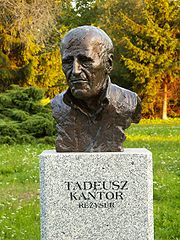
Tadeusz Kantor
Encyclopedia

Poland
Poland , officially the Republic of Poland , is a country in Central Europe bordered by Germany to the west; the Czech Republic and Slovakia to the south; Ukraine, Belarus and Lithuania to the east; and the Baltic Sea and Kaliningrad Oblast, a Russian exclave, to the north...
painter
Painting
Painting is the practice of applying paint, pigment, color or other medium to a surface . The application of the medium is commonly applied to the base with a brush but other objects can be used. In art, the term painting describes both the act and the result of the action. However, painting is...
, assemblage
Assemblage (art)
Assemblage is an artistic process. In the visual arts, it consists of making three-dimensional or two-dimensional artistic compositions by putting together found objects...
artist, set designer and theatre director. Kantor is renowned for his revolutionary theatrical performances in Poland and abroad.
Life and career
Born in Wielopole SkrzyńskieWielopole Skrzynskie
Wielopole Skrzyńskie is a village in Ropczyce-Sędziszów County, Subcarpathian Voivodeship, in south-eastern Poland. It is the seat of the gmina called Gmina Wielopole Skrzyńskie...
, Galicia (then in Austria-Hungary
Austria-Hungary
Austria-Hungary , more formally known as the Kingdoms and Lands Represented in the Imperial Council and the Lands of the Holy Hungarian Crown of Saint Stephen, was a constitutional monarchic union between the crowns of the Austrian Empire and the Kingdom of Hungary in...
), Kantor graduated from the Cracow Academy in 1939. During the Nazi occupation of Poland, he founded the Independent Theatre, and served as a professor at the Academy of Fine Arts in Kraków as well as a director of experimental theatre in Kraków
Kraków
Kraków also Krakow, or Cracow , is the second largest and one of the oldest cities in Poland. Situated on the Vistula River in the Lesser Poland region, the city dates back to the 7th century. Kraków has traditionally been one of the leading centres of Polish academic, cultural, and artistic life...
from 1942 to 1944. After the war, he became known for his avant-garde work in stage design including designs for Saint Joan (1956) and Measure for Measure (1956). Specific examples of such changes to standard theatre were stages that extended out into the audience, and the use of mannequins as real-life actors.
Disenchanted with the growing institutionalization of avant-garde, in 1955 he with a group of visual artists formed a new theatre ensemble called Cricot 2
Cricot 2
Cricot 2 was a Polish theatre company based in Cracow. It was founded in 1955 by groundbreaking theatre director and theorist Tadeusz Kantor....
. In the 1960s, Cricot 2 gave performances in many theatres in Poland and abroad, gaining recognition for their stage happenings. His interest was mainly with the absurdist
Absurdism
In philosophy, "The Absurd" refers to the conflict between the human tendency to seek value and meaning in life and the human inability to find any...
s and Polish writer and playwright Stanisław Ignacy Witkiewicz (also known as "Witkacy"). Stage productions of Witkacy's plays The Cuttlefish (1956) and The Water Hen (1969) were regarded as his best achievements during this time. A 1972 performance of The Water Hen was described as "the least-publicised, most talked-about event at the Edinburgh festival
Edinburgh Festival
The Edinburgh Festival is a collective term for many arts and cultural festivals that take place in Edinburgh, Scotland each summer, mostly in August...
".

His later works of the 1980s were very personal reflections. As in Dead Class, he would sometimes represent himself on stage. In the 1990s, his works became well known in the United States
United States
The United States of America is a federal constitutional republic comprising fifty states and a federal district...
due to presentations at Ellen Stewart
Ellen Stewart
Ellen Stewart was an American theater director and producer and the founder of La MaMa, E.T.C. . In the 1950s she worked as a fashion designer for Saks Fifth Avenue, Bergdorf Goodman, Lord & Taylor, and Henri Bendel.-Biography:Ellen Stewart was either born in Alexandria, Louisiana or Chicago,...
's La MaMa Experimental Theater Club.
Throughout his life, Kantor had an interesting and unique relationship with Jewish culture, despite being a nominal Catholic and having a father with anti-Semitic tendencies, Kantor incorporated many elements of what was known as "Jewish theatre" into his works.
Kantor died in Kraków.
Major Manifestos and Writing
- The Autonomous Theatre (1963)
- Theatre Happening: The Theatre of Events (1967)
- The Informal Theatre (1969)
- The Zero Theatre (1969)
- The Theatre of Death (1975)
Productions with Cricot 2
- The Cuttlefish (1956)
- The Country House (1961)
- The Madman and the Nun (1963)
- The Water Hen (1965)
- Dainty Shapes and Hairy Apes, or the Green Pill (1972)
- The Dead Class (1975)
- Wielopole, Wielopole (1981)
- Let the Artists Die (1985)
- I Shall Never Return (1989)
- Today is my Birthday (1990)
External links
- Tadeusz Kantor at culture.pl
- Cricoteka The Centre For the Documentation of the Art of Tadeusz Kantor
- Kantor's gallery at malarze.com
- Demarco European Art Foundation images of Edinburgh performances by Tadeusz Kantor
- In Search of Kantor Details of show being performed in Edinburgh 2007 based on Kantor
- Cricot 2's website
- Art Signature Dictionary, genuine signature by the artist Tadeusz Kantor Here are several dated examples of Tadeusz Kantor signature.

